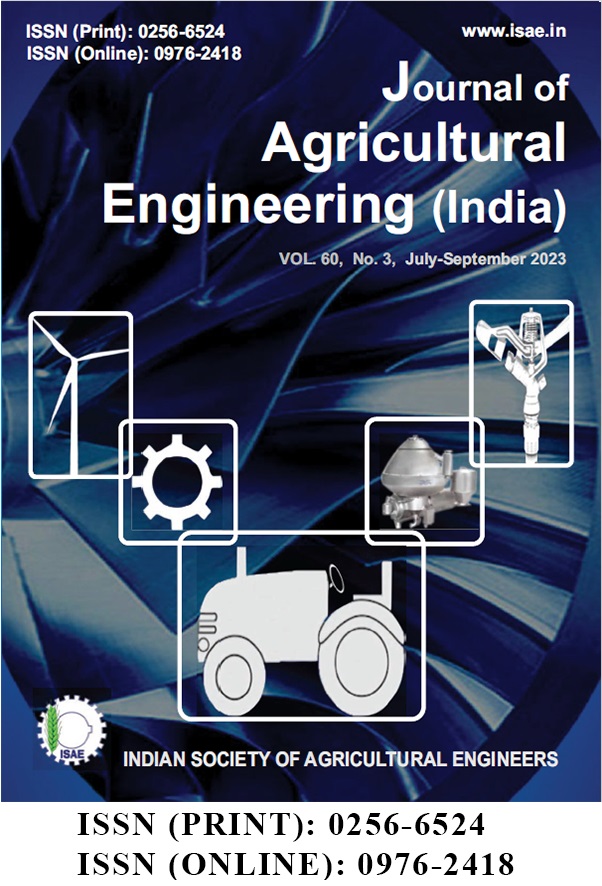Energy, Exergy, Emergy, Environment, and Economics Analysis of a Three-pot Cookstove
DOI:
https://doi.org/10.52151/jae2023603.1814Keywords:
Biomass, cookstove, renewable, socio-economic, sustainability, transformityAbstract
As per World Bank's collection of development indicators, about 65% of India's population still live in rural regions, where biomass will continue to be the primary source of energy for cooking. Consumers and governments are concerned about the amount of energy used in cooking. Furthermore, the use of biomass fuel in traditional biomass stoves has been associated with human health, with women being more susceptible to exposure to indoor air pollution and health issues during cooking. This study analysed the performance of a three-pot cookstove suitable for a family of 6 persons with respect to its energy, exergy, emergy, environment, and economics. Emergent indicators such as percent renewable (PR), emergent yield ratio (EYR), environmental load ratio (ELR), and environmental sustainability index (ESI) are accustomed to assessing the environmental load and native sustainability of biomass energy. According to Emergy indicators, the production of three-pot cooking system is more sustainable than traditional cookstove systems. Further, the p-value, standard deviation and coefficient of variance derived from the statistical analysis indicate a significant relationship between feedstock size and thermal efficiency of the developed cookstove.
References
Abeliotis K; Pakula C. 2013. Reducing health impacts of biomass burning for cooking-the need for cookstove performance testing. Energy Effic., 6, 585-594. https://doi.org/10.1007/s12053-013-9193-y
Bandgar P S; Panwar N L; Jain S; Rathore N. 2022. Thermal modelling and experimental validation for biogas production in anaerobic digestion. Bioresour. Technol. Reports, 101243. https://doi.org/10.1016/j.biteb.2022.101243
Bastianoni S; Marchettini N. 2000. The problem of co-production in environmental accounting by emergy analysis. Ecol. Modell., 129, 187-193. https://doi.org/10.1016/S0304-3800(00)00232-5
Brown M T; Ulgiati S. 2004. Energy quality, emergy, and transformity: H.T. Odum’s contributions to quantifying and understanding systems. Ecol. Modell., 178, 201-213. https://doi.org/10.1016/j.ecolmodel.2004.03.002
Chica E; Pérez J F. 2019. Development and performance evaluation of an improved biomass cookstove for isolated communities from developing countries. Case Stud. Therm. Eng., 14, 100435. https://doi.org/10.1016/j.csite.2019.100435
Hau J L; Bakshi B R. 2004. Promise and problems of emergy analysis. Ecol. Modell., 178, 215-225. https://doi.org/10.1016/j.ecolmodel.2003.12.016
Kees M; Feldmann L. 2011. The role of donor organisations in promoting energy efficient cook stoves. Energy Policy, 39,7595-7599. https://doi.org/10.1016/j.enpol.2011.03.030
Lombardi F; Riva F; Bonamini G; Barbieri J; Colombo E. 2017. Laboratory protocols for testing of Improved cooking stoves (ICSs): A review of state-of-the-art and further developments. Biomass Bioenergy, 98, 321-335. https://doi.org/10.1016/j.biombioe.2017.02.005
Lu H F; Tan Y W; Zhang W S; Qiao Y C; Campbell D E; Zhou L; Ren H. 2017. Integrated emergy and economic evaluation of lotus-root production systems on reclaimed wetlands surrounding the Pearl River Estuary, China. J. Clean Prod., 158, 367-379. https://doi.org/10.1016/j.jclepro.2017.05.016
Mehetre S A; Panwar N L; Sharma D; Kumar H. 2017. Improved biomass cookstoves for sustainable development: A review. Renewable Sustain. Energy Rev,, 73, 672-687. https://doi.org/10.1016/J.RSER.2017.01.150
Mehetre S A; Sengar S H; Panwar N L; Ghatge J S. 2016. Performance evaluation of improved carbonized cashew nut shell based cookstove. Waste and Biomass Valorization, 7. 1221-1225. https://doi.org/10.1007/s12649-016-9497-1
Narnaware S; Panwar N L. 2022. Pyrolysis kinetics of lignocellulosic waste biomass (Cicer arietinum) using iso-conversional methods. J. Agric. Eng., 59 (3), 293- 299. https://doi:10.52151/jae2022593.1783
Odum H T. 1996. Environmental Accounting: Emergy and Environmental Decision Making. John Wiley and Sons, New York, pp: 384. ISBN: 978-0-471-11442-0
Odum H T. 1998. Emergy evaluation. Int. Work Adv. Energy Stud. Energy flows Ecol. Econ., 1, 13
Panwar N L. 2014. Energetic and exergetic performance evaluation of improved biomass cookstoves. Int. J. Exergy, 14. https://doi.org/10.1504/IJEX.2014.062910
Panwar N L; Paul A. 2017. Energetic and exergetic evaluation of biomass fired water heating system. Trends Renewable Energy, 3, 153-159. https://doi.org/10.17737/tre.2017.3.2.0043
Patel M R; Rathore N; Panwar N L. 2021. Influences of biochar in biomethanation and CO2 mitigation potential. Biomass Convers. Biorefinery, https://doi. org/10.1007/s13399-021-01855-6
Pizzigallo A C I; Granai C; Borsa S. 2008. The joint use of LCA and emergy evaluation for the analysis of two Italian wine farms. J. Environ. Manage., 86, 396- 406. https://doi.org/10.1016/j.jenvman.2006.04.020
Pulselli R M; Simoncini E; Pulselli F M; Bastianoni S. 2007. Emergy analysis of building manufacturing, maintenance and use: Em-building indices to evaluate housing sustainability. Energy Build., 39, 620-628. https://doi.org/10.1016/j.enbuild.2006.10.004
Singh N; Kumar C; Rathore N; Panwar N. 2022. Thermal performance and heat storage behaviour of three pots improved cookstove. Energy Nexus, 6, 100074. https://doi.org/10.1016/j.nexus.2022.100074
Tigabu A; Berkhout F; van Beukering P. 2017. Development aid and the diffusion of technology: Improved cookstoves in Kenya and Rwanda. Energy Policy, 102, 593-601. https://doi.org/10.1016/j.enpol.2016.12.039
Ulgiati S; Odum H T; Bastianoni S. 1994. Emergy use, environmental loading and sustainability an emergy analysis of Italy. Ecol. Modell., 73, 215-268. https://doi.org/10.1016/0304-3800(94)90064-7
Urmee T; Gyamfi S. 2014. A review of improved Cookstove technologies and programs. Renewable Sustain. Energy Rev., 33, 625-635. https://doi.org/10.1016/j.rser.2014.02.019
Wassie Y T; Adaramola M S. 2021. Analysis of potential fuel savings , economic and environmental effects of improved biomass cookstoves in rural Ethiopia. J. Clean Prod., 280, 124700. https://doi.org/10.1016/j.jclepro.2020.124700
Yip F; Christensen B; Sircar K. 2017. Assessment of traditional and improved stove use on household air pollution and personal exposures in rural western Kenya. Environ. Int., 99, 185-191. https://doi.org/10.1016/j.envint.2016.11.015














